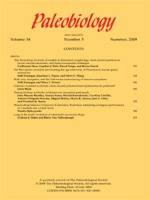Two simple plate parameters, P, the height of the plate measured normal to the plate base, and α, the angle formed between the plate base and the adjacent edge of that plate, serve to model crinoid aboral cup morphology. With few exceptions, the resulting theoretical geometries replicate the range of calyx morphology observed in the natural world. A theoretical morphospace, derived from these parameters, encompasses both the realized and unrealized possibilities of crinoid calyx construction. The model and the associated morphospace demonstrate that the occupation of crinoid cup space varies non-uniformly in time and space and suggest that functional constraints and/or ecological habit are important components of the distribution of cup morphology in time.
How to translate text using browser tools
1 March 2007
Theoretical morphology of the crinoid cup
David C. Kendrick
ACCESS THE FULL ARTICLE
<
Previous Article
|

Paleobiology
Vol. 33 • No. 2
March 2007
Vol. 33 • No. 2
March 2007




